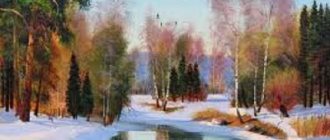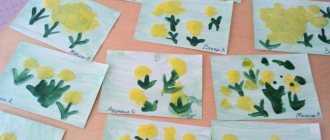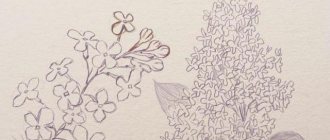Notes on drawing for children of the senior group on the theme “Spring has come”
Municipal budgetary institution MBDOU d/s No. 21
City of Novocherkassk
Summary of a lesson for children of the senior group on cognitive development on the topic “Spring has come.”
Author: Dolmat Ekaterina Vladimirovna
Tasks:
1. To consolidate children’s knowledge about the seasons, about changes in nature in the spring.
2. Learn to create a landscape composition, depicting nature in spring.
3.Develop visual - imaginative thinking, attention, speech, creative abilities.
4. Foster a caring attitude towards nature.
5.Cultivate accuracy in painting with paints.
Objectives: Clarify the signs of spring;
form ideas about spring Formation of children's ideas about the genre of painting - landscape.
Equipment : magnetic board, slides depicting landscapes, still life, book by K. Ushinsky, watercolor paints, brushes, sippy cups, sheets of white paper, oilcloth lining, napkins .
Vocabulary work:
still life, landscape, portrait.
Progress of the lesson
Organizing time
In the morning it was sunny and quite warm. A wide lake flowed across the yard. At noon it froze, Winter came again, The lake was covered with a crust of glass.
I split the thin, ringing glass, and the wide lake began to flow again. Passers-by say: “Spring is coming!” And this is me working, breaking the ice.
Conversation: Educator: Guys, I want to show you a picture. (Painting by I. Levitan “The Last Snow”).
What time of year do we see in the picture? (Spring). That's right guys, it's spring! And if the painting depicts forests, fields, seas, rivers, lakes, mountains, a city, a village - what is the name of such a painting?
(scenery). Well, of course, guys, this is a landscape. Now Oleg will read us a poem about the landscape: If you see a river drawn in a picture, Or a spruce and white frost, Or a garden and clouds, Or a snowy plain, Or a field and a hut, - The picture is definitely called ..... (landscape).
Riddles about spring.
The snow is melting, the meadow has come to life.
The day comes, when does it happen? (Spring)
I open the buds into green leaves.
I dress the trees, water the crops,
Full of movement, they call me... (Spring)
I
will read you an excerpt from a story by Konstantin Ushinsky, and you listen carefully.
“The sun not only stays in the sky longer, but also warms up noticeably more every day. At first, thawed patches appear in the fields, but soon the ground, wet and saturated with water, appears everywhere from under the snow. Another week will pass, then another, and the snow will only remain somewhere in a deep ravine where the sun does not shine. The trees also awaken from winter sleep and, warmed by the sun, are filled with juices. The sky is getting bluer and the air is getting warmer.
— What time of year is the author talking about? (about spring).
Preview:
Lesson notes on visual arts
in the preparatory group
Drawing according to the theme: “Spring outside”
The goal is to develop the ability to conceive the content of your drawing and bring the idea to completion.
- Teach children to paint a picture of early spring;
- Learn to use different art materials in drawing;
- Enrich children's speech with emotionally charged vocabulary.
- Develop the ability to use a palette to prepare the desired shade of color, sample paint;
- Develop the ability to dilute watercolor paints with water to obtain light colors;
- Develop emotional responsiveness to the spring awakening of nature.
- To cultivate in children an aesthetic perception of spring nature.
- Cultivate love for your native land.
Equipment: reproductions of paintings about spring, album sheets, watercolor paints, colored pencils, wax crayons, felt-tip pens, palette, brushes, cups of water, napkins.
Educator: Our land is beautiful in all seasons, and each time is beautiful in its own way. But there is a time in nature when nature awakens from winter sleep and lives in anticipation of warmth and sun. When do you think this happens?
Children: this happens in the spring.
Educator: Indeed, in the spring. What an affectionate and gentle word - spring! Spring brings everyone the joy of life, the joy of creativity and activity! This feeling covers all people, and poets write poetry, composers write music, artists write paintings. Now I will read poems about spring, and you close your eyes and imagine what I will read about...
The snow is still white in the fields, And in the spring the waters are noisy - They run and wake up the sleepy shore, They run and shine and shout - They shout to all ends: “Spring is coming, spring is coming! We are messengers of the young spring, She sent us forward.” (F. Tyutchev)
Driven by the spring rays, There is already snow from the surrounding mountains
They fled through muddy streams.
To the flooded meadows. Nature's clear smile
Through a dream they greet the morning of the year. (A. Pushkin)
Educator: Have you seen spring? What mood did the poets convey?
Children: The poets conveyed a joyful, cheerful mood.
Educator: You and I have read many poems about spring, and all of them are joyful. Why do you think?
Children: Winter is ending, the cold and frost are leaving. Spring is coming. The sun is shining brighter. Thawed patches and the first snowdrops appear. Birds return from the south and sing their merry songs.
Educator: Spring comes with its own palette of colors. What colors are on it? The teacher draws the children's attention to the exhibition of reproductions of paintings about spring and gives them the opportunity to examine them.
“Colors of Spring” IOD in the senior group
Compiled by:
Frolova Elena Alexandrovna,
teacher
MADO kindergarten No. 100 in Tyumen
“Colors of Spring” Summary of integrated educational activities in the senior group
Program content:
1. Continue teaching children to mix paints to obtain new shades (when painting with gouache). To develop artistic and creative abilities.
2. Improve children's ability to create expressive images using non-traditional drawing techniques.
3. Continue to develop interest in visual arts.
4. Clarify and generalize children’s ideas about the characteristic signs of spring. Expand children's knowledge about spring, enrich and activate children's vocabulary (batik, palette).
Preliminary work: observations in nature, conversations about spring, listening to audio recordings with the sounds of spring, looking at paintings and illustrations about spring, guessing riddles about spring, learning poems about spring, finger gymnastics.
Equipment: cube with tasks, pictures depicting different seasons, cut-out pictures, white fabric, pieces of white fabric for each child, gouache paints, palette, brushes, napkins, jars of water, stands for brushes.
Integration of educational areas: speech development, artistic and aesthetic development, cognitive development.
Node progress:
1. Organizational moment.
Educator: Guys, remember last week we found a flower with tasks in the group? And today, I found such an interesting cube in the group. It's colorful, has six sides, and has pockets. And in these pockets, as I understand it, there are tasks for you. What are we going to do with the cube? Let's see the assignments? Will we be able to fulfill them? Want to? (children's answers).
Dice game
Educator: Where do you think we’ll take the first task?
Children: From number 1
Educator: Why did you decide that? I agree with you, I think so too, if there is a number 1, let’s start with it. So, Yura, help me get the first task. And there, guys, is some beautiful note. And the note says that we must help spring come as soon as possible. Shall we help you guys? What do you think of it?
Children: Let's help.
Educator: Guys, which side will we choose next?
Children: Side with number 2.
Educator: Karina, please find the right side (the child finds the right side).
Educator: What color is it?
Children: Red.
Educator: So, listen to the task: “Choose a picture from the set and tell us about it” (children are given pictures depicting different seasons, children must choose pictures depicting spring).
Educator: Well done, guys! You found all the pictures correctly. I think we have completed task number 2! What do you think Vika?
Educator: Guys, the next task will be numbered...?
Children: 3.
Educator: Angelina, what color is this side of the cube?
Child: Blue
Educator: Medina, did Angelina name the color correctly?
Child: That's right.
Educator: Yes, guys. Let's see what task is hidden in this pocket. Varya, please help me get the task. Assignment: “Tell a poem about spring.” Ilyusha, tell your poem to the boys, and you, Varya, tell your poem to the girls (the children share, Ilya tells the poem to the boys, Varya tells the girls).
Teacher: 1 - 2 boys run here. 1 – 2 girls run here.
Ilya: It gets light early in the morning. Thaws here and there. The stream roars like a waterfall, Starlings fly to the birdhouse, Drops ring under the roofs, The bear gets up from the spruce tree, The sun caresses everyone with warmth.
Varya: Spring is coming towards us with quick steps, And the snowdrifts are melting under her feet. Black thawed patches are visible in the fields, You can see the very warm feet of spring.
Educator: Well done, guys! Such beautiful poems told about spring. Thank you very much! Now, guys, let's continue to complete the tasks. Which side will we choose next?
Children: number 4
Educator: Gleb, find the right side (the child finds the right side).
Educator: Yura, what color is she?
Child: green
Educator: Yana, please take the fourth task out of your pocket. The next task, guys, is called “Collect a picture” (children are given cut-out pictures depicting spring primroses, children are divided into subgroups and collect pictures).
Educator: Guys, what have we collected?
Children: we collected flowers.
Educator: What flowers are these?
Children: These are spring primroses.
Educator: Look, guys, how beautiful and tender they are, like spring itself. Well done guys, you coped with this task too.
Educator: Guys, which side will we choose next?
Children: Side number 5.
Educator: Medina, please find the right side (the child finds the right side).
Educator: Varya, what color is she?
Child: Orange.
Teacher: Vika, please take the fifth task out of your pocket (the child takes out the task)
Educator: But what task awaits us here: “Play with your fingers.”
Finger gymnastics: (performed by a child)
A wonderful flower grew in a clearing,
On a spring morning he opened his petals,
Beauty and nutrition to all petals
Together they grow roots underground.
Educator: Well done, guys! Alice, which side will we choose next?
Child: At number 6.
Educator: Karina, what color is this side?
Child: Brown
Educator: Help me, Gleb, get the last task.
Educator: Oh, there’s something interesting here (the child takes out a white cloth with 2–3 colors painted in gouache on it). Something else fell out here. This is another message from spring.
"Dear Guys! Winter has washed away all the colors from my skirt. There are only a few flowers left. Draw exactly the same flowers in color"
Educator: Guys, can we help?
Children: Let's help.
Educator: I can draw such flowers. They are made using the batik technique, such an interesting word. Let's repeat it with you. I will definitely tell you how this is done. To paint flowers using the batik technique, we need to choose exactly the same paints. Here's what we have (they're looking at paints), unfortunately, we don't have the paints we need. What to do? Can be mixed. We will all work together now. And then everyone will draw their own flower.
Educator: How do we get a pink tint? To do this, we need to add red paint to the white paint. We will do all this with the help of a palette, but you can also take a white piece of paper. The brush should be held between three fingers (thumb and middle, holding it on top with the index finger), behind the iron tip, without squeezing it too tightly with your fingers. Dip the brush into the paint with all the bristles, then remove the excess drop on the edge of the jar; Before taking another paint, rinse the brush in water and blot it on a napkin.
Educator: Now, in the same way we will try to get a blue tint. We add blue to white paint and get blue.
Educator: We received all the paints. Let's move on to drawing flowers using the batik technique. Place the fabric on the oilcloth and straighten it. Take a rubber band, roll it up, tie it into a knot (the height of the tail may vary). Apply paint at the top, center and bottom. At the next stage, remove the elastic band, unfold the material and, using a brush, add leaves to the flowers. This is the flower I got. And now you will master the new batik technique. Everyone goes to work. Choose paints, get to work, don’t forget about the rules for mixing paints.
Independent activity of children.
Review of finished works.
Educator: We have one minute left. Finish and bring all the work here. Let's look at what interesting flowers you got. What are they good for? (children's answers)
Result:
Educator: Let's leave our flowers to dry. Then we will iron them and sew them onto our spring fabric. Do you think we managed to find spring colors and help spring?
Literature used: Sample general education program for preschool education “From birth to school.” Edited by N.E. Veraksa, T.S. Komarova, M.A. Vasilyeva. 3rd edition, corrected and expanded, publishing house Mozaika - Sintez, Moscow, 2014.
“Fine motor skills” gymnastics for fingers, author T.A. Tkachenko. EKSMO Publishing House, Moscow 2015
“Certificate of publication in the media” Series A No. 0005857
We invite teachers of preschool education in the Tyumen region, Yamal-Nenets Autonomous Okrug and Khanty-Mansi Autonomous Okrug-Yugra to publish their teaching materials: - Pedagogical experience, original programs, teaching aids, presentations for classes, electronic games; — Personally developed notes and scenarios of educational activities, projects, master classes (including videos), forms of work with families and teachers.
Why is it profitable to publish with us?
1. “Kindergartens of the Tyumen Region” is an officially registered specialized media outlet at the federal level. 2. The activities of the editorial office are supported by the Department of Education and Science of the Tyumen Region 3. We issue a “Certificate of Publication” in the media. 4. The document has a unique number, is entered in the register, has the original seal of the editorial office of the online publication and signature. 5. “Certificate of publication” in the media is sent to the author in both paper and electronic versions.
Details >>>
Sample “Certificate of publication of author’s methodological material in the media.”pdf
Share
Abstract of OOD on drawing in the senior group “Spring Landscape”
Rimma Siyanova
Abstract of OOD on drawing in the senior group “Spring Landscape”
Topic: " Spring landscape "
.
1. Learn to create a landscape composition , depicting nature in spring in accordance with the laws of perspective.
2. To consolidate children’s knowledge about the seasons, about changes in nature in the spring.
3. Develop visual - imaginative thinking, attention, speech, creative abilities in non-traditional drawing .
4. Foster a caring attitude towards nature.
Presentation " Spring Landscape "
, sheets of white thick paper, watercolors, brushes, jars of water, napkins, cabbage leaves, cotton swabs, toothbrushes.
Works "Snowdrop"
P. Tchaikovsky,
“The Rustle of Spring”
by K. Sinding,
“Spring”
– 1 part from the cycle “The Seasons” by A. Vivaldi.
Presentation “Spring in the paintings of artists”
with reproductions of paintings
of spring landscapes by famous artists and landscape painters
. Memorizing poems about spring, reading works of natural history, observing while walking (thawed patches, puddles and streams, blue spring sky , migratory birds returning from warm lands, asking riddles about spring.
- Extend your hands to a friend (children stand in a circle,
Hold hands tightly (hold hands)
.
I am your friend and you are my friend, (turn and look at each other,
It turned out to be a friendly circle (raise hands up)
.
Good afternoon to you, kids,
Glad to see you always!
Guys, today, when I was going to kindergarten, I met... And you can guess who!
It gets light early in the morning,
Program content: consolidate the ability to decorate a silhouette with the help of ornaments and patterns, using plant elements and others in accordance with the theme; consolidate and enrich knowledge about the season - spring; improve technical skills and abilities: use different visual materials; arouse in children creative interest, emotional responsiveness, desire to create; develop imagination and creativity.
Materials and aids for the lesson:
- Silhouettes of paper dresses: white and tinted (blue, light green, pink, purple).
- Felt pens, oil pastels, gel pens.
- Model of a spring doll (flat), where you can insert dress silhouettes.
Preliminary work: conversation about spring, reading poems, songs; examination of still lifes: N. Zhukov “Still life with daisies”, P. Konchalovsky “Lilac”; looking at book illustrations; reading T. Kryukova “All Year Round”.
Progress of the lesson
Music by P.I. Tchaikovsky "Seasons. Spring".
— Do you often encounter miracles?
I can assure you guys that miracles happen not only every day, but every minute. You just need to really, really want to see them and be very attentive.
- Do you want me to tell you how many miracles I saw today?
A whole clearing of yellow dandelions appeared near my house this morning, but yesterday they weren’t there yet. I saw ladybugs on a stump.
-What miracles did you see? Tell us! (Children's stories).
-Who does these miracles? Of course - Spring.
Reading a poem by S.D. Drozhzhin "Spring Kingdom".
- Guys, why is spring called a sorceress? (Children's answers).
- True. Spring waved one sleeve - it spread green carpets, waved the other - painted flowers bloomed on the carpets. She placed the hot, blazing sun on the heavenly throne.
And here comes a wonderful surprise. Vesna-Krasna decided to send her portrait, but it was unusual, but with a surprise. (Show that you can insert silhouettes).
Every day spring brings something new to nature; and she has become such a fashionista, she just has time to change her outfits, she’s even tired of inventing them.
Well, do you want to celebrate spring?
Then let's get to work. (Children choose silhouettes, select materials).
“I’d like to tell you a secret that spring likes clothes to contain only what is associated with this time of year. So be careful. And what will we use to decorate sundresses? (Children name elements, objects).
To make it beautiful, you need to make a pattern from these objects and elements that you named.
Independent activity of children.
— The wonderful music of a spring stream and the singing of birds will help you (music sounds).
Children show their works and talk about them.
On the topic: methodological developments, presentations and notes
Program content:1. To form in children an aesthetic vision of nature in works of fine art, to evoke an emotional response to beauty.
Introducing children to paintings by Russian painters, listening to musical works and artistic activities.
Introducing children to paintings by Russian painters, listening to musical works and artistic activities.
Introducing children to paintings by Russian painters, listening to musical works and artistic activities.
Introducing children to paintings by Russian painters, listening to musical works and artistic activities.
Source




